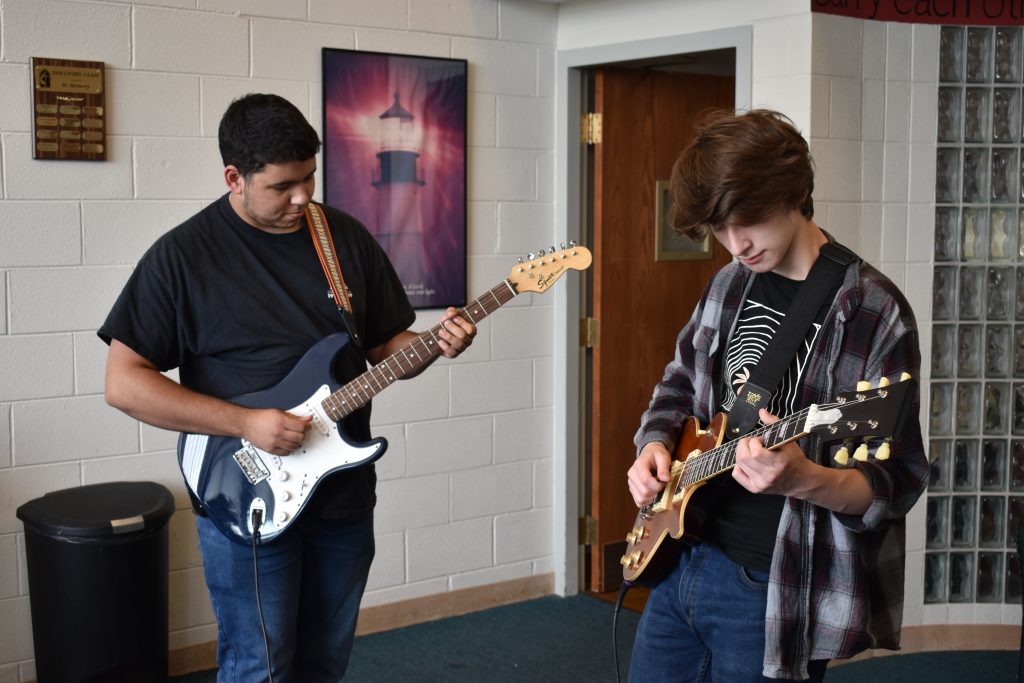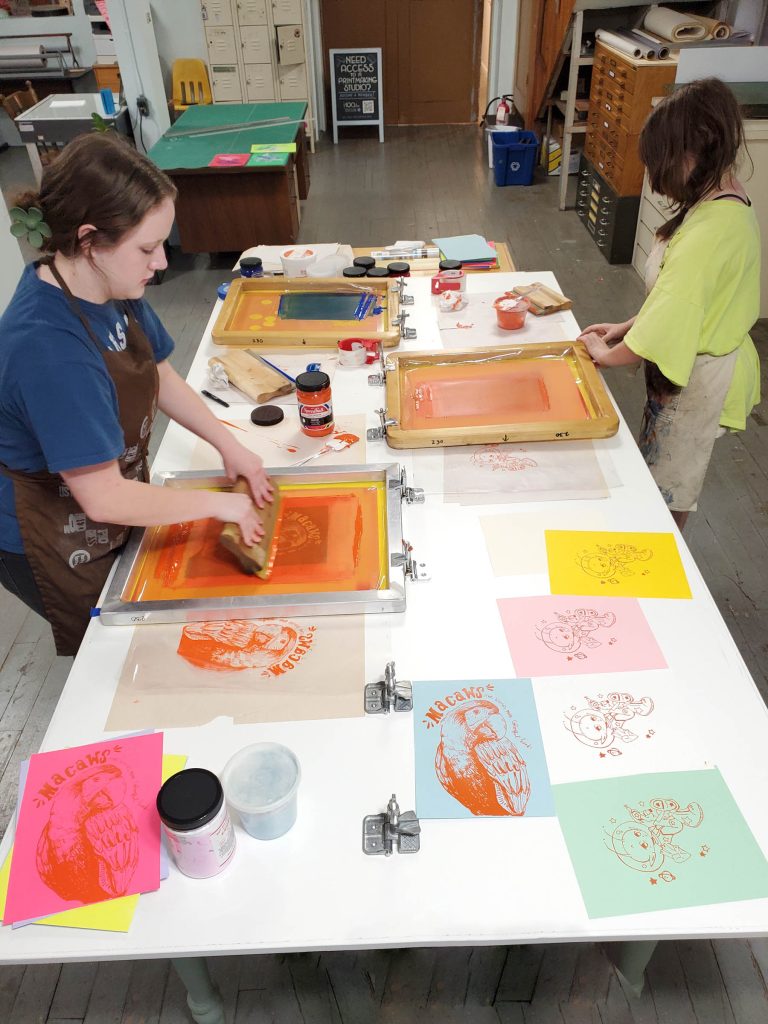Community School of the Arts celebrates creativity with kids
When Jamison Stalsworth was about 10 years old, he began hanging around the Community School of the Arts. His older sister participated in an art class there, and Stalsworth liked to sneak in and play with the clay. A few years later he enrolled in the art class himself, and later he picked up guitar lessons. He worked with visual artists as mentors in the school’s Side by Side program. And now he works in a creative field, as producer and director for Draft Agency.
Skip ahead a decade or two and Stalsworth’s son, Destry, is a student at the nonprofit after-school arts school. A South-Doyle Middle School student, Destry started in the visual arts program and also takes guitar lessons from local musician Greg Horne. “It started as something to have fun with, and the more I learn, the more invested I get,” he says. Looking ahead, he can envision himself in a music- or art-related career.
A few doors down from where Destry takes his lessons is Leah Goldsberry, a freshman at L&N STEM Academy, and Hope Ray, a homeschooled sophomore. They work on art with printmaker Ashton Ludden. “I feel like I learn more here than in the standard art classes at school,” Goldsberry says. “We try lots of media,” says Ray. “We’re learning a lot of things.”
For 30 years, the Community School of the Arts has inspired Knoxville students to explore their creative sides. It’s recruited professional artists and musicians to serve as instructors and mentors. And it’s offered an opportunity for kids to grow and learn and, in many instances, pursue their artistic passions into adulthood.
History and How it Works

The Community School of the Arts had its roots at First Presbyterian Church. The late Rev. Dr. Carswell Hughs had been installed as the church’s pastor, and he came to it with the idea of an arts school similar to the one his previous church in Charlotte, North Carolina, had set up, says CSA executive director Jennifer Willard.
An Air Force brat from Alaska with parents who were Knoxville natives, Willard had a background in arts management. She was coordinating the fine arts programs at the University of Alabama in 1992 when her dad learned of the CSA and the need for someone to run it.
“I did not want to get involved with a startup,” she recalls. “But they did everything exactly the way it should have been done. They formed a steering committee and incorporated separately from the church, and appointed a very diverse board and officers, and set up a charter and bylaws… All the paperwork was done up front. I was bowled over by them, and I guess the feeling was mutual. By the time I got back to my parents’ house from my interview, they had called to make me an offer. I felt like the skillsets I had built over the years—grant writing, fund raising, writing press releases, putting on a production—all led to this.”
The programming at the school started small and grew each year. “We started with piano in 1992,” Willard says. “Then we added art. Then violin. Then guitar. What we didn’t foresee was that the kids would stick with it year after year. Most of our students starting out were 7, 8, 9 years old. We thought they’d take some piano lessons and call it a day. When we saw they didn’t want to go anywhere, we realized we’d have to grow with them.”
Now the program serves about 125 students, age 7 to 18, each year with free lessons in piano, jazz piano, violin, guitar, brass, percussion, visual arts and dance. This year, music lessons and visual arts classes will continue through the summer. “Going forward we plan to always offer a truncated schedule during the summer,” Willard says. CSA also is the after-school arts provider for Green Magnet Academy.
All CSA students are from families that would not be able to pay for private lessons. “We look at every situation on its own merits,” Willard says. “Would this child benefit from what we offer? Is the family willing to make the commitment to get them here, and be involved, and take care of the instrument we loan them?”
How much the students participate is also dependent on each child. “Some take piano and violin and dance. When they’re young they want to do everything, and we encourage them to do so. By the time they’re in high school, they have usually narrowed it down to one or two things they love.”

Big Changes
Probably the biggest change that’s occurred at the CSA since its beginning is its change of location. After years of being housed on five floors of First Presbyterian Church, it was faced with relocating when the church took on a major renovation project. A board member invited Willard to look at space at Church Street United Methodist Church. As it happened, the senior day care program that was held at Church Street closed its doors at about the same time, so space was available for CSA’s classes.
“It was an amazing setup,” Willard says. “It was everything we had at First Presbyterian, but on one floor. There was a check-in desk and a kitchen and a gym. Now we’re part of the ministry here, but we’re not subsidized by the church.” Still, the church makes an in-kind gift of custodial services and utilities to the nonprofit, and offers access to its sanctuary for performance space and its reception areas for meetings and other gatherings.
Though CSA has been at Church Street since 2018, Willard still feels like the location is new to them. After they did some renovating and got settled in, it wasn’t long before everything changed when Covid shut things down in early 2020.
“We were able to switch our lessons to remote and made sure all our students had access to equipment, WiFi, whatever they needed, and we didn’t miss a beat,” Willard says “With the art teachers, we put together some ideas for specific projects they could do at home, including progressive projects they’d mail to each other to help them stay connected. Only dance and percussion classes were canceled.”
Because many of their instructors, all of whom are paid by the school, are professional artists and musicians, they were struggling to make ends meet during the pandemic. “The board agreed to pay them for their full schedules,” she says. “We were remote for a year and a half. In the fall of 2021, we brought some classes back. We had our first post-Covid in-person senior recital at the end of last school year.”

Side by Side
One program that was put on hold during Covid was the nonprofit’s Side by Side apprentice program, in which a local professional artist pairs with a CSA student for four to six months each year. Students, who must have completed at least two years of visual art classes at CSA, experienced every aspect of the creative process under the tutelage of professionals. Each year culminated in an art exhibition at Bennett Galleries. Currently, the Side by Side program is rebuilding with the hope of restarting next school year.
Knoxville husband-and-wife glassmakers Richard Jolley and Tommie Rush have worked with students in Side by Side since its inception in 1997. Jeremiah Washington, a recent Pellissippi State graduate, was among the last of their apprentices before Covid shut the program down. He worked with them throughout high school.
“I showed up at their studio and fell in love with them,” Jeremiah says. “Them caring about me and taking me in as one of their own really drew me in. They even got me a job at Bennett Galleries working in the warehouse.
“What surprised me most was how understanding they were,” he says. “When I start a project, I don’t have a specific idea in mind. I go with the flow, and I was afraid they would criticize me about it. Richard was able to work with me on that, and we were able to come up with some creative ideas. I had fun spending time with him and Tommie. They were like second parents to me.”
“It’s not that we want to turn them into artists,” Tommie Rush says of their Side by Side students. “It’s a way to mentor children. We talk about anything they want to talk about. We try to focus on teamwork, and we talk about the mathematics and chemistry and physics that go into what we do. But the overriding thing you’re doing is telling a child they’re worth your time.
“We never dumbed anything down for the kids,” she says. “They rise to your expectations. We want kids to feel they can do anything they want to do. And we want to show them how big the world can be.”
Looking Ahead
In addition to returning Side by Side to its programming, Willard says CSA wants to reintroduce the culinary arts, creative writing, and dramatic arts to its class schedule. They also want to establish more performing ensembles in the future.
“While it’s true that many of our graduates have gone on to become professional musicians and artists—the latter most notably in graphic design—most have pursued post-education and careers that are not arts-adjacent, such as environmental engineering, chemistry, mathematics, social work, psychology, medicine, and nuclear engineering,” Willard says. “Our goal at the Community School of the Arts is to create a confident, well-rounded individual who is curious about the world and their place in it. The arts are our medium for that empowerment.”
